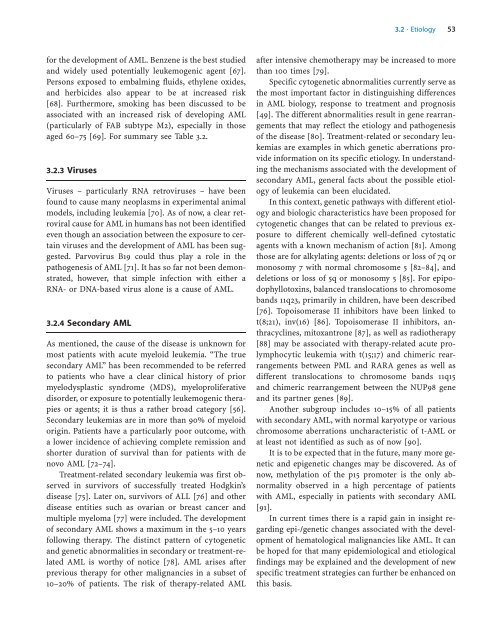Acute Leukemias - Republican Scientific Medical Library
Acute Leukemias - Republican Scientific Medical Library
Acute Leukemias - Republican Scientific Medical Library
Create successful ePaper yourself
Turn your PDF publications into a flip-book with our unique Google optimized e-Paper software.
a 3.2 · Etiology 53<br />
for the development of AML. Benzene is the best studied<br />
and widely used potentially leukemogenic agent [67].<br />
Persons exposed to embalming fluids, ethylene oxides,<br />
and herbicides also appear to be at increased risk<br />
[68]. Furthermore, smoking has been discussed to be<br />
associated with an increased risk of developing AML<br />
(particularly of FAB subtype M2), especially in those<br />
aged 60–75 [69]. For summary see Table 3.2.<br />
3.2.3 Viruses<br />
Viruses – particularly RNA retroviruses – have been<br />
found to cause many neoplasms in experimental animal<br />
models, including leukemia [70]. As of now, a clear retroviral<br />
cause for AML in humans has not been identified<br />
even though an association between the exposure to certain<br />
viruses and the development of AML has been suggested.<br />
Parvovirus B19 could thus play a role in the<br />
pathogenesis of AML [71]. It has so far not been demonstrated,<br />
however, that simple infection with either a<br />
RNA- or DNA-based virus alone is a cause of AML.<br />
3.2.4 Secondary AML<br />
As mentioned, the cause of the disease is unknown for<br />
most patients with acute myeloid leukemia. “The true<br />
secondary AML” has been recommended to be referred<br />
to patients who have a clear clinical history of prior<br />
myelodysplastic syndrome (MDS), myeloproliferative<br />
disorder, or exposure to potentially leukemogenic therapies<br />
or agents; it is thus a rather broad category [56].<br />
Secondary leukemias are in more than 90% of myeloid<br />
origin. Patients have a particularly poor outcome, with<br />
a lower incidence of achieving complete remission and<br />
shorter duration of survival than for patients with de<br />
novo AML [72–74].<br />
Treatment-related secondary leukemia was first observed<br />
in survivors of successfully treated Hodgkin’s<br />
disease [75]. Later on, survivors of ALL [76] and other<br />
disease entities such as ovarian or breast cancer and<br />
multiple myeloma [77] were included. The development<br />
of secondary AML shows a maximum in the 5–10 years<br />
following therapy. The distinct pattern of cytogenetic<br />
and genetic abnormalities in secondary or treatment-related<br />
AML is worthy of notice [78]. AML arises after<br />
previous therapy for other malignancies in a subset of<br />
10–20% of patients. The risk of therapy-related AML<br />
after intensive chemotherapy may be increased to more<br />
than 100 times [79].<br />
Specific cytogenetic abnormalities currently serve as<br />
the most important factor in distinguishing differences<br />
in AML biology, response to treatment and prognosis<br />
[49]. The different abnormalities result in gene rearrangements<br />
that may reflect the etiology and pathogenesis<br />
of the disease [80]. Treatment-related or secondary leukemias<br />
are examples in which genetic aberrations provide<br />
information on its specific etiology. In understanding<br />
the mechanisms associated with the development of<br />
secondary AML, general facts about the possible etiology<br />
of leukemia can been elucidated.<br />
In this context, genetic pathways with different etiology<br />
and biologic characteristics have been proposed for<br />
cytogenetic changes that can be related to previous exposure<br />
to different chemically well-defined cytostatic<br />
agents with a known mechanism of action [81]. Among<br />
those are for alkylating agents: deletions or loss of 7q or<br />
monosomy 7 with normal chromosome 5 [82–84], and<br />
deletions or loss of 5q or monosomy 5 [85]. For epipodophyllotoxins,<br />
balanced translocations to chromosome<br />
bands 11q23, primarily in children, have been described<br />
[76]. Topoisomerase II inhibitors have been linked to<br />
t(8;21), inv(16) [86]. Topoisomerase II inhibitors, anthracyclines,<br />
mitoxantrone [87], as well as radiotherapy<br />
[88] may be associated with therapy-related acute prolymphocytic<br />
leukemia with t(15;17) and chimeric rearrangements<br />
between PML and RARA genes as well as<br />
different translocations to chromosome bands 11q15<br />
and chimeric rearrangement between the NUP98 gene<br />
and its partner genes [89].<br />
Another subgroup includes 10–15% of all patients<br />
with secondary AML, with normal karyotype or various<br />
chromosome aberrations uncharacteristic of t-AML or<br />
at least not identified as such as of now [90].<br />
It is to be expected that in the future, many more genetic<br />
and epigenetic changes may be discovered. As of<br />
now, methylation of the p15 promoter is the only abnormality<br />
observed in a high percentage of patients<br />
with AML, especially in patients with secondary AML<br />
[91].<br />
In current times there is a rapid gain in insight regarding<br />
epi-/genetic changes associated with the development<br />
of hematological malignancies like AML. It can<br />
be hoped for that many epidemiological and etiological<br />
findings may be explained and the development of new<br />
specific treatment strategies can further be enhanced on<br />
this basis.
















